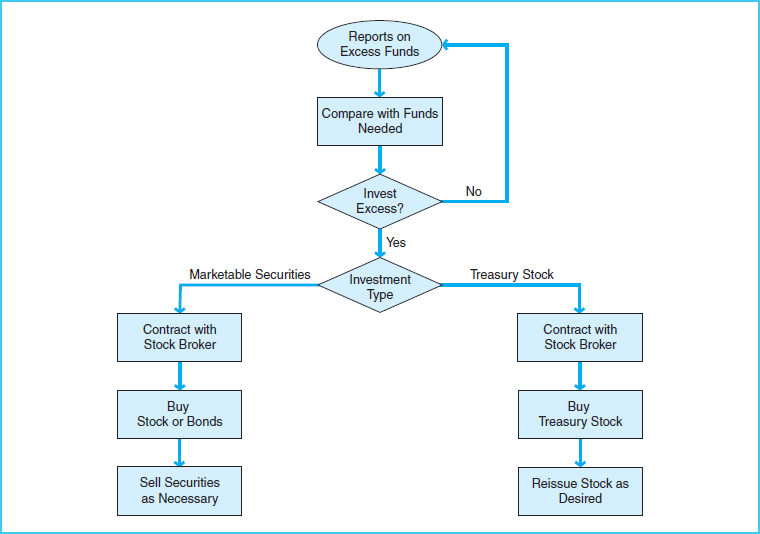INVESTMENT PROCESSES (STUDY OBJECTIVE 3)
In many instances, an organization finds that it has more funds on hand than necessary to operate the organization. The proper performance of the stewardship function would suggest that management should invest these excess cash funds in a place where they can earn a return. Management should properly manage, or administer, the investment of excess funds. Investment processes authorize, execute, manage, and properly account for investments of excess funds. While there are several ways for a corporation to invest such funds, the most frequently used methods would be to invest in marketable securities or repurchase the company's outstanding common stock. Marketable securities are stocks or bonds purchased on open securities markets. A corporation's own stock that is repurchased by the company on the open market is called treasury stock. Exhibit 12-4 shows the processes of investing excess funds.
Regardless of how the excess funds are invested, there should be a set of administrative processes that authorize, execute, and properly account for the investments. It is important to recognize that investment processes should not be initiated unless top management has no immediate plans to use those funds. Top management should be continually monitoring the funds available and considering the future need for funds. Thus, the recognition that there are excess funds and the related decision to authorize the investment of those funds are administrative (top management) functions. Usually, the treasurer of the corporation (or those under the authority of the treasurer) has the responsibility for making investment decisions and overseeing investments.
The parties that make up top management depend upon the type of organization. For a corporation, the board of directors is the top management level that authorizes and controls source of capital processes. For partnerships or proprietorships, the owners are the top managers. For the purpose of explaining the processes in Exhibit 12-4, a corporation with a board of directors is the type of organization and management depicted.

Exhibit 12-4 Investment Process Map
Securities and treasury stock often are not purchased directly on the market; rather, a brokerage firm is used to execute the purchase. After purchasing securities or treasury stock, the treasurer of the company often maintains custody of the securities and the record of those securities. In some companies, a trustee is used to maintain custody of the securities or records of the securities. At some point in the future, management will likely determine that there are more important or profitable uses for invested funds. The securities or treasury stock can then be resold through a broker.
Since most large corporations have complex IT accounting systems, the accounting system can automate much of the investment processes, including notifying management when excess funds exist. That is, the IT system can forecast future cash needs and future cash inflows by monitoring the expected timing of future accounts payable due dates and future collections of accounts receivable. The system can continually compare current cash balances with forecasted needs and sources, and provide feedback to top management about potential excess funds.
